When it comes to Pu-erh tea, one of the most fascinating aspects is its ability to age and evolve over time. Unlike other teas that lose freshness after a year, Pu-erh—especially Sheng (raw) and Shou (ripe) varieties—improves with age, developing deep, complex flavors. But what’s the real difference between Sheng and Shou Pu-erh, and how does aging play a role?
In this blog, we’ll demystify these two types of Pu-erh tea and help you discover which one suits your taste and lifestyle.
What Is Pu-erh Tea?
Pu-erh tea (普洱茶) is a post-fermented tea made from sun-dried, large-leaf tea grown in Yunnan, China. It's known for its earthy, rich flavors and for the fact that it can improve over time—sometimes aging for decades.
Sheng Pu-erh (Raw Pu-erh): Naturally Aged
-
Processing: The tea leaves are picked, sun-dried, and then compressed into cakes without any artificial fermentation.
-
Flavor Profile (young): Fresh, vegetal, floral, with a slight bitterness.
-
Flavor Profile (aged): Smooth, woody, and sweet, often with notes of dried fruit or Chinese herbs.
-
Color: Light golden to amber, depending on age.
-
Aging Potential: Excellent. Sheng Pu-erh continues to evolve over 10–30+ years under proper storage conditions.
-
Best For: Tea connoisseurs who appreciate subtlety and the journey of aging tea.
Sheng Pu-erh is often called the “green tea of Pu-erh” when young, but with age, it becomes something entirely unique.
Shou Pu-erh (Ripe Pu-erh): Fast-Fermented Comfort
-
Processing: Uses an accelerated fermentation process known as “wo dui” (wet piling), which mimics the aging of Sheng in just a few months.
-
Flavor Profile: Earthy, mellow, smooth, often with notes of dark wood, cocoa, and a hint of sweetness.
-
Color: Dark reddish-brown or almost black.
-
Ready to Drink: Yes. Shou Pu-erh can be enjoyed immediately after production.
-
Aging Potential: Can also age well, but aging changes are more subtle than with Sheng.
-
Best For: New tea drinkers or anyone who prefers a smooth, dark brew without bitterness.
Think of Shou as the “instant vintage” Pu-erh—deep and grounding, perfect for everyday comfort.
Raw vs. Ripe: Which One Should You Choose?
| Feature | Sheng Pu-erh | Shou Pu-erh |
|---|---|---|
| Fermentation Method | Natural over time | Accelerated (wet piling) |
| Taste (young) | Bright, floral, slightly bitter | Earthy, mellow, smooth |
| Aging | Improves dramatically | Improves subtly |
| Drinkability | Needs years to mellow | Ready to drink |
| Best for | Aging, collecting, exploring | Daily drinking, digestion |
The Art of Aging Pu-erh
Pu-erh is one of the few teas that gets better with age, especially when stored in a cool, dry, well-ventilated space. Over time:
-
Bitterness softens
-
Sweetness develops
-
Aromas deepen
-
Energy ("Cha Qi") strengthens
A well-aged Sheng Pu-erh is often described as smooth, warming, and meditative.
Final Thoughts
Whether you're drawn to the complex evolution of Sheng Pu-erh or the instant warmth of Shou Pu-erh, both teas offer something deeply rewarding. Understanding the difference between raw and ripe Pu-erh helps you choose the right tea for the right moment—whether that’s mindful aging or immediate enjoyment.
Pu-erh is not just tea—it’s a journey through time, flavor, and tradition.


